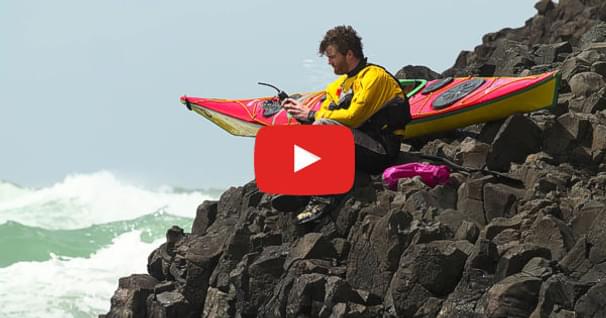Basic River Running
Almost anyone can point their kayak straight down a class two, and even class three river, and paddle down successfully. If you can identify and follow the middle of the downstream V, you're able to paddle easy rapids. As long as you keep your boat pointed downstream, and your momentum the same as or faster than the current; your body forward and your hips loose, you'll have a great time.
These are the four things you can do to remain stable and upright while paddling:
Hit Waves Head-On
Hitting waves head-on at a right angle, allows you to punch through them. For reactionary waves, this means that you'll want to angle your boat towards the wave, instead of keeping your kayak pointed down the tongue. If you don't angle your boat toward the wave, then it will hit you from the side and push you offline, or flip you over. To know what's coming up, and when you may need to change your angle, it's important to lift your gaze and look ahead.
Anticipate
Anticipation is key in whitewater kayaking, because you're traveling on a dynamic medium. You can't wait until you're at the rock to go around it, because it will be too late. You need to be looking at where you want to go early, so that you can have time to make your move. Lift your vision and look where you want to go, and you'll stay upright more easily.
TAHE 10'6 & 11'6 SUP-YAK Inflatables
2-in-1 Kayak & Paddle Board complete packages for single or tandem use.
Paddling Posture
Sit up straight and keep your weight slightly forward when you kayak. Leaning back is a sure way to get flipped over. In general, the sterns of our kayaks are smaller than our bows. So when we lean back, we place all of our weight on the back of our kayak, which sinks it into the water, and makes it more vulnerable to being overtaken by the river. Not to mention that leaning back throws us off balance. It's important to be very aware of our upper body position, and make sure that we sit up straight when we paddle, and lean forward in the rapids.
"When in Doubt, Keep Paddling."
This is fantastic advice for beginners.
When you have an active blade in the water, it's tough to flip over because your paddle blades act like braces. Also if your kayak is traveling as fast as, or faster than the current, it's more stable and less vulnerable to swirlies. As you progress, it's time to slow the paddling down, and paddle more efficiently. Taking the right strokes at the right time, will help your paddling look and feel more effortless. The same rule still applies though. When in doubt, keep an active blade in the water.
It's important here to define active blade. This means a paddle blade that is actively moving in the water doing something useful. Sticking your paddle in the water and trying to lean on it, is not considered using an active blade. Dragging or leaning on your paddle is another great way to get off balance and flip over.
Related Articles
How many of you have ever heard that paddle craft (vessels under oars according to the Navigation Rules)…
Even though they are flipping over, missing their gates and failing their maneuvers, they still look…
It's important to know when to call for help. If a situation isn't getting better, and you don't think…
The following is a modified excerpt from Ken Whiting's book, 'The Ultimate Guide to Whitewater…




